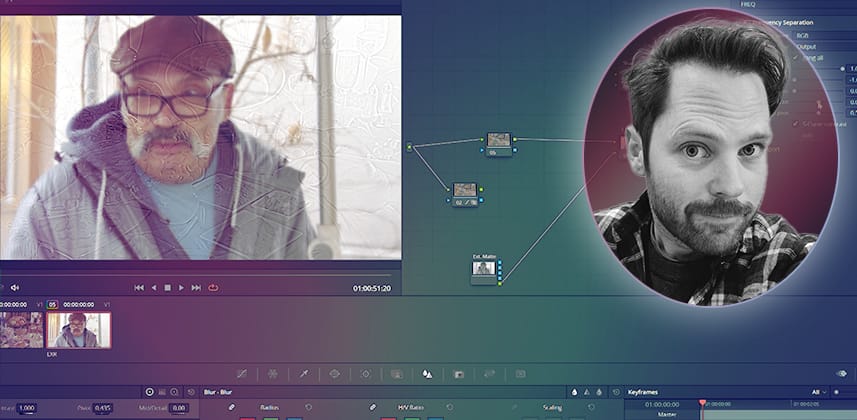Publishers note: Team Mixing Light is thrilled to welcome our newest Contributor, Marty Webb!
He is a Senior Colourist and Head of Picture Finishing for a boutique post house in Soho, London, leading a team of finishing artists working on a broad range of content, scripted and unscripted, for clients such as Netflix, Sky, HBO, BBC… among many others.
In addition to grading, Marty also spends time on workflow and developing efficiencies to help streamline post processes. He automates the boring stuff to dedicate more time to the creative side of colour grading.
Please welcome Marty in the comments below. You can get more links for him on his Author page.
How to save noisy secondary operations by mimicking Baselight’s Texture Blend operation
Frequency Separation a a great technique for controlling your image, and Baselight’s Texture Blend tools have some powerful real-world use cases.
In this Insight, you’ll learn to recreate its functionality in DaVinci Resolve and also use a free Resolve plugin to achieve the same result with more nuance.
When making a secondary adjustment that reveals noise, you can use this technique to apply an adjustment to lower frequencies in an image to avoid seeing noise or artifacts revealed by the adjustment. The Lum vs. Hue adjustment is a typical culprit in this scenario: A client asks to lower the brightness of a color while keeping its saturation – and noise suddenly pops up, forcing you to broaden the operation, even if you don’t want to.
In this Insight, I’ll show you how to save this operation using this relatively simple Texture Blend technique in a compound node.
Key takeaways from this Insight
By the end of this Insight, you should understand how to:
- Use texture blending in your node tree
- Apply frequency separation to create a compound node with Texture Blend capabilities
- Use Paul Dore’s Frequency Separation OFX to replace your blur operations
Note: This node tree is fairly simple to execute, and I strongly feel it helps you understand what we’re doing if you build it yourself. However, Premium members can download the .drx in the Additional Downloads section.
External Links
- Texture Management in Baselight With Andy Minuth – A 30-minute presentation, “Colourist Andy Minuth puts these tools to practical use. He covers all of the features based on FilmLight’s advanced frequency separation techniques: Texture Equaliser, Texture Highlight and Texture Blend.”
- Frequency Separation OFX Download – Paul Dore’s GitHub repository of the frequency separation OFX discussed at the end of this Insight. NOTE: As mentioned in the comments, the Bald Avenger Mac OS plugins may have stopped working with Mac OS Ventura.
Related Mixing Light Insights
- Film Print Emulation: Paul Dore’s ACES DCTL Look Modification Transform (LMT) – Another Paul Dore image tool reviewed on Mixing Light.
- Creative Coding With DCTL: Part 2 – Learn how to set up and use the GitHub repository.
- Frequency Separation: An Introduction – When working with skin, it’s easy to make it look false and overworked.
- Beauty work using frequency separation in Fusion – Igor Ridanovic leverages the stabilization work of the new Surface Tracker plugin to execute beauty work on the Fusion page.
Questions or Comments? Leave a comment!
Is this Insight useful to you? Let us know! Mixing Light is all about community discussions and we’re curious if you found this helpful, if you have something to add, or if you have more questions you need answered?
– Marty
Additional Downloads
Sorry... downloads are available for Premium Members only.
Become a Premium Member

